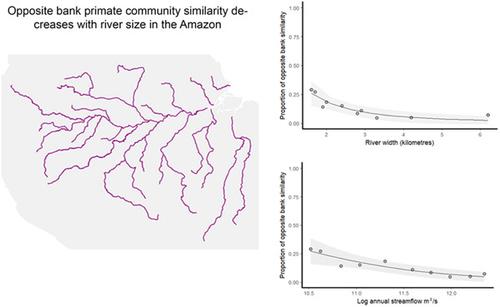当前位置:
X-MOL 学术
›
Am. J. Primatol.
›
论文详情
Our official English website, www.x-mol.net, welcomes your
feedback! (Note: you will need to create a separate account there.)
Effect of river size on Amazonian primate community structure: A biogeographic analysis using updated taxonomic assessments.
American Journal of Primatology ( IF 2.0 ) Pub Date : 2020-04-23 , DOI: 10.1002/ajp.23136 Gail Fordham 1 , Sam Shanee 2 , Mika Peck 1, 2
American Journal of Primatology ( IF 2.0 ) Pub Date : 2020-04-23 , DOI: 10.1002/ajp.23136 Gail Fordham 1 , Sam Shanee 2 , Mika Peck 1, 2
Affiliation

|
The mechanisms that underlie the diversification of Neotropical primates remain contested. One mechanism that has found support is the riverine barrier hypothesis (RBH), which postulates that large rivers impede gene flow between populations on opposite riverbanks and promote allopatric speciation. Ayres and Clutton‐Brock (1992) demonstrated that larger Amazonian rivers acted as barriers, delineating the distribution limits of primate species. However, profound changes in taxonomy and species concepts have led to the proliferation of Neotropical primate taxa, which may have reduced support for their results. Using the most recent taxonomic assessments and distribution maps, we tested the effect of increasing river size on the similarity of opposite riverbank primate communities in the Amazon. First, we conducted a literature review of primate taxonomy and developed a comprehensive spatial database, then applied geographical information system to query mapped primate ranges against the riverine geography of the Amazon watershed to produce a similarity index for opposite riverbank communities. Finally, we ran models to test how measures of river size predicted levels of similarity. We found that, almost without exception, similarity scores were lower than scores from Ayres and Clutton‐Brock (1992) for the same rivers. Our model showed a significant negative relationship between streamflow and similarity in all tests, and found river width significant for the segmented Amazon, but not for multiple Amazon watershed rivers. Our results support the RBH insofar as they provide evidence for the prediction that rivers with higher streamflow act as more substantial barriers to dispersal, and accordingly exhibit greater variation in community composition between riverbanks.
中文翻译:

河流规模对亚马逊河灵长类动物群落结构的影响:使用最新分类学评估的生物地理分析。
新热带灵长类动物多样化的基础机制仍然存在争议。已获得支持的一种机制是河流屏障假设(RBH),该假设推测,大河流阻碍了相对河岸人口之间的基因流动,并促进了异源物种形成。Ayres and Clutton-Brock(1992)证明,较大的亚马逊河充当屏障,描绘了灵长类物种的分布范围。但是,分类学和物种概念的深刻变化导致了新热带灵长类动物分类单元的扩散,这可能减少了对其结果的支持。使用最新的分类学评估和分布图,我们测试了增加河流规模对亚马逊河对岸灵长类动物群落相似性的影响。第一,我们对灵长类生物分类学进行了文献综述,并开发了一个综合的空间数据库,然后应用地理信息系统针对亚马逊流域的河流地理环境查询映射的灵长类动物范围,以产生相对河岸社区的相似性指数。最后,我们运行模型来测试河流规模的度量如何预测相似度。我们发现,几乎没有例外,相同河流的相似性得分均低于Ayres和Clutton-Brock(1992)的得分。我们的模型在所有测试中均显示出流量与相似性之间的显着负相关关系,并发现分段河段的河宽很明显,但对于多条亚马逊分水岭河却没有。
更新日期:2020-06-23
中文翻译:

河流规模对亚马逊河灵长类动物群落结构的影响:使用最新分类学评估的生物地理分析。
新热带灵长类动物多样化的基础机制仍然存在争议。已获得支持的一种机制是河流屏障假设(RBH),该假设推测,大河流阻碍了相对河岸人口之间的基因流动,并促进了异源物种形成。Ayres and Clutton-Brock(1992)证明,较大的亚马逊河充当屏障,描绘了灵长类物种的分布范围。但是,分类学和物种概念的深刻变化导致了新热带灵长类动物分类单元的扩散,这可能减少了对其结果的支持。使用最新的分类学评估和分布图,我们测试了增加河流规模对亚马逊河对岸灵长类动物群落相似性的影响。第一,我们对灵长类生物分类学进行了文献综述,并开发了一个综合的空间数据库,然后应用地理信息系统针对亚马逊流域的河流地理环境查询映射的灵长类动物范围,以产生相对河岸社区的相似性指数。最后,我们运行模型来测试河流规模的度量如何预测相似度。我们发现,几乎没有例外,相同河流的相似性得分均低于Ayres和Clutton-Brock(1992)的得分。我们的模型在所有测试中均显示出流量与相似性之间的显着负相关关系,并发现分段河段的河宽很明显,但对于多条亚马逊分水岭河却没有。











































 京公网安备 11010802027423号
京公网安备 11010802027423号